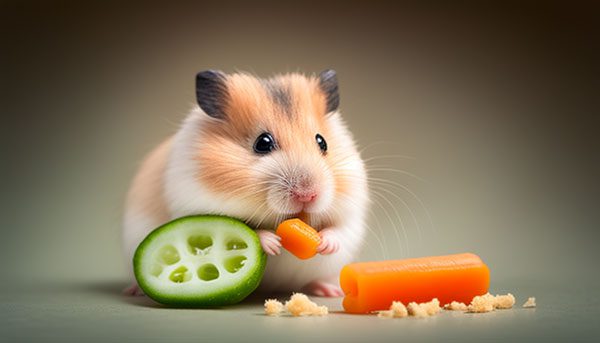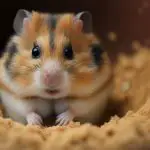Why Is My Hamster Not Eating and Drinking
Hamsters have a high metabolism. This means that they need to eat and drink regularly to maintain their health and energy levels. But if your hamster isn’t eating or drinking, it’s important to figure out why.
So, why is your hamster not eating and drinking? There could be several reasons, including illness, stress and changes in diet. Observing your hamster’s behavior and seeking veterinary advice is necessary in this case. Otherwise, a lack of food and water can lead to dehydration and serious health issues.
This article will help you understand the causes, consequences and ways to encourage your hamster to eat and drink. Read on to understand more.
Common Causes of Hamsters Not Eating and Drinking
When a hamster stops eating and drinking, it can be a sign that something is wrong. Let’s narrow down to the major causes of hamsters not eating and drinking.

Illness
Just like any other animal, body complications can contribute to your hamster not eating and hydrating. Some of the common illnesses that can cause this type of behavior in hamsters include respiratory infections, digestive issues, and skin problems.
Dental Issues
Hamsters have continuously growing incisors that need to be kept short by gnawing and chewing. If they aren’t properly worn down, they can get overgrown and cause discomfort or pain. This will make it difficult for your hamster to eat and drink.

Other than the teeth overgrowing, tooth injury is another dental issue that can cause your hamster not to eat and drink.
Stress and Anxiety
Hamsters are creatures of habit and are sensitive to changes in their environment. If you’ve recently introduced new pets, changed their cage, or made any other significant changes to their surroundings, they may feel stressed and anxious.
And this can cause them to lose their appetite and dehydrate.
Poor Diet
Hamsters are omnivores and need a balanced diet of both dry food and fresh fruits and vegetables. If you’re feeding your hamster an unbalanced diet or not providing enough water, it can lead to its loss of appetite
Consequences of Hamster Not Eating and Drinking
Five major consequences come with your hamster not eating and drinking. Let’s delve into each of these consequences in a bit more detail.

1. Dehydration
When a hamster does not drink enough water, their body loses fluids and can quickly become dehydrated. If left unattended, this can cause serious complications to your hamster that may even be fatal.
Some of the symptoms of dehydration include dry mouth, sunken eyes and a lack of energy.
2. Malnourishment
Malnourishment is the lack of proper nutrition. Hamsters require a balanced and nutritious diet to maintain their health and therefore, when they do not eat and drink, they become malnourished.
And this can lead to a number of health problems. Malnourished hamsters may have weak immune systems, making them more liable to infections and diseases.

They may also suffer from poor growth and development, and in severe cases, malnourishment can cause a hamster’s organs to fail, leading to death.
3. Digestive Problems
The digestive system of a hamster is delicate and requires proper care to function correctly. Therefore, when a hamster does not eat enough food, their digestive system slows down, and it may experience constipation or other digestive problems.
Over time, this can lead to blockages or even damage to the digestive tract.
4. Weakness
Despite being known for their playful nature, failing to eat and drink might affect a hamster’s energy levels negatively, making them weak and lethargic. They may be less active, and their movement may be slow and uncoordinated.
5. Increased Risk of Illness and Infection
When a hamster is not eating and drinking, they become more susceptible to illness and infection. This is because a weakened immune system cannot fight off diseases and infections as effectively.
Additionally, a hamster’s body may not be able to produce enough white blood cells to fight off bacteria and viruses.
How to Encourage a Hamster to Eat and Drink?
Being a hamster owner, you know that it’s essential to ensure that your pet stays healthy and happy. One of the ways to achieve this is by encouraging your hamster to eat and drink. Here are some tips on how to encourage your hamster to eat and drink.

Offering Fresh Food and Water
Feeding your hamster pongy or unfresh food and water might actually be the reason for the lack of appetite. Therefore, it is best if you provide fresh fruits and vegetables to your hamster. This might encourage them to eat and drink. Additionally, a bowl of fresh water is necessary for hydration.
Adjusting the Feeding Schedule
If you notice that your hamster isn’t eating and drinking at all or as much as they usually do, it’s time to adjust its feeding schedule.
Some hamsters are nocturnal and prefer to eat and drink during the night, so consider feeding them during their active hours. This adjustment can encourage them to eat and drink.
Providing a Comfortable and Stress-Free Environment
A hamster that’s anxious or stressed may refuse to eat and drink. Ensuring that their cage is clean, adequately ventilated, and has enough room for them to move around might actually motivate the hamster to eat and drink.

Additionally, make sure that they have access to toys and a wheel to exercise and play.
Seeking Veterinary Care if Necessary
Lastly, if your hamster is still not eating and drinking, consider taking them to a veterinarian. It could be a sign of an underlying medical condition that needs treatment. A veterinarian can diagnose and treat the illness if there’s any, helping your hamster to regain their appetite and stay healthy.
If you’re concerned about your hamster’s well-being, you may find our articles on how many babies hamsters have and how to care for a dying hamster useful. Our article on how many babies hamsters have provides insights into hamster reproduction, including the gestation period and the best ways to care for the mother and her litter. Meanwhile, our article on how to care for a dying hamster offers advice on how to make your hamster as comfortable as possible during their final days.FAQ
Here are some of the frequently asked questions for your further clarification on this matter.
Q: What Are the Symptoms of a Sick Hamster?
Symptoms of a sick hamster may include lethargy, loss of appetite, diarrhea or constipation, abnormal discharge from the eyes, nose or ears, difficulty breathing, hair loss, abnormal behavior, and changes in the appearance or texture of the fur or skin.
Q: How Often Should I Change My Hamster’s Water?
Changing a hamster’s water at least once a day is recommended. Hamsters need access to clean, fresh water at all times, as they can become dehydrated quickly. If the water becomes contaminated with food, bedding or feces, it should be changed more frequently.
Conclusion
In conclusion, seeing your hamster not eating or drinking is concerning, but there are several reasons why this can occur. By understanding the common causes, you can take the necessary steps to ensure that your hamster stays healthy and happy.
Remember, your hamster relies on you for their well-being, so be proactive and attentive to their needs to keep them healthy and happy. If you suspect that your hamster is unwell, it is always best to take them to the vet as soon as possible to receive the proper diagnosis and treatment.




